Short Fatigue-Crack Growth from Crack-like Defects under Completely Reversed Loading Predicted Based on Cyclic R-Curve
Abstract
:1. Introduction
2. Simulation Procedure
3. Fatigue Growth Threshold of Short Cracks from Precracks
3.1. Buildup of Crack Closure with Crack Extension
3.2. Growth and Arrest of Short Cracks
3.3. Effect of Precrack Length on Growth and Arrest of Short Cracks
3.4. Fatigue Threshold Diagram
4. Cyclic R-Curve for Predicting Short Crack Growth
4.1. Cyclic R-Curve Determined by Constant Amplitude Loading of Precracked Specimens
4.2. Extension of R-Curve for Longer Crack Region
4.3. Inclusion of Crack Initiation Stage in R-Curve
5. Concluding Remarks
- (1)
- At crack initiation, the crack-tip opening stress is equal to the applied minimum stress and increases sharply with crack extension. The effective range of stress intensity factor ΔKeff first drops and then changes to increase. Under the assumption of the threshold value of ΔKeff for steels as ΔKeffth = 3 MPa, the crack is arrested when ΔKeff drops below ΔKeffth.
- (2)
- There are two fatigue limits: Δσw1 is for crack initiation and Δσw2 is for fracture. As the precrack length becomes longer, the amount of extension of the onpropagating crack at Δσw2 becomes larger and the threshold SIF range, ΔKth, approaches a steady state value for long cracks ΔKthlc.
- (3)
- The threshold SIF range ΔKth consists of two components: ΔKeffth and ΔKopth, where ΔKeffth is constant and ΔKopth is an increasing function of crack extension Δanp. The relation between ΔKth and Δanp, called cyclic R-curve, is independent of the initial precrack length. Two fitting functions proposed for R-curves will be useful to determine R-curves from limited experimental data.
- (4)
- Load-shedding or ΔK-constant loading tests can be adapted to extend the cyclic R-curve beyond the fatigue limit of a precracked specimen under constant amplitude loading. For a given precrack length, the relation between ΔKth and the crack extension Δa is unique, following the fitted functions.
- (5)
- For precracks shorter than the initiation crack length a1, the crack initiation stage of forming a crack length of a1 should be taken into account in R-curves. The length of the initiation crack, a1, is determined from the fatigue limit of smooth specimens, Δσw0, and the R-curve having the crack initiation stage.
- (6)
- The propagation of the initiation crack of length a1 controls the fatigue limit of smooth specimens. The initiation crack length may correspond to the length at the transition from microstructurally short cracks to mechanically/physically short cracks and is several times larger than the grain size.
Author Contributions
Funding
Institutional Review Board Statement
Informed Consent Statement
Data Availability Statement
Conflicts of Interest
Appendix A. Simulation of PICC Buildup Using a Modified Strip-Yield Model
- (i)
- Lumping of elements in the crack wake is carried out in order to suppress the increase of the number of elements due to crack extension.
- (ii)
- Under the maximum stress, σmax, the crack opening displacement (COD) is determined as the sum of CODs due to the applied stress and to the yield stress, σY, in the plastic zone.
- (iii)
- During unloading to the minimum stress, σmin, the stress in the plastic zone is reversed to yield in compression, and the crack faces start to contact. As described above, the initial clearance is assumed for open (Type I) precrack surfaces. The stresses in the plastic zone and on the contacted crack wake are determined by solving the simultaneous linear equations for element stresses with the Gauss-Seidel method. The element stress, σi, is modified as follows: (a) For the whole region, if σi < −σY, then σi = −σY. (b) For elements in the crack wake, if σi > 0, then σi = 0. (c) For elements in the plastic zone, if σi > σY, then σi = σY, because the material is assumed to be perfectly plastic.
- (iv)
- The crack-tip opening stress, σop, is determined from the contact stress on the crack face.
- (v)
- At the minimum stress, the crack is extended by da, and one element of size da is added behind the crack tip. The amount of crack extension in one cycle of simulation is determined as 0.2% of the maximum plastic zone size.
- (vi)
- After crack extension, the above process of computation is repeated until the crack reaches a prescribed length or is arrested because of increasing crack closure.
References
- Frost, N.E.; Marsh, K.J.; Pook, L.P. Matal Fatigue; Clarendon Press: Oxford, UK, 1974; pp. 130–201. [Google Scholar]
- Isibasi, T. Prevention of Fracture and Fatigue; Yokendo: Tokyo, Japan, 1967; pp. 52–86. [Google Scholar]
- Nisitani, H. Effects of size on the fatigue limit and the branch point in rotary bending tests of carbon steel specimens. Bull. JSME 1968, 11, 947–957. [Google Scholar] [CrossRef]
- Nakazawa, H.; Kobayashi, H.; Morita, A.; Itakura, S.; Miyauchi, K.; Ishii, Y. Fatigue crack growth and fatigue limit of smooth and notched specimens of low-carbon steel with various grain sizes. Trans. Jpn. Soc. Mech. Eng. 1974, 40, 9–19. [Google Scholar] [CrossRef]
- Tamura, M.; Yamada, K.; Shimizu, M.; Kunio, T. Endurance limit and nonpropagating crack behavior of ferritic pearlitic steels. Trans. Jpn. Soc. Mech. Eng. 1983, 49, 1378–1386. [Google Scholar] [CrossRef]
- Yamada, I.; Yamada, K.; Kunio, T. Effect of grain size on threshold behaviour of small crack in plain carbon steel. Trans. Jpn. Soc. Mech. Eng. 1986, 52, 412–416. [Google Scholar] [CrossRef]
- Tachibana, S.; Kawachi, S.; Yamada, K.; Kunio, T. Effect of grain refinement on the endurance limit of plane carbon steels at various strength levels. Trans. Jpn. Soc. Mech. Eng. 1988, 54, 1956–1961. [Google Scholar] [CrossRef]
- Tanaka, K.; Akiniwa, Y.; Nakano, M.; Kinefuchi, M. Propagation threshold and crack closure of small fatigue cracks. Trans. Jpn. Soc. Mech. Eng. 1990, 56, 715–722. [Google Scholar] [CrossRef]
- Smith, R.A.; Miller, K.J. Prediction of fatigue regimes in notched components. Int. J. Mech. Sci. 1978, 20, 201–206. [Google Scholar] [CrossRef]
- El Haddad, M.H.; Dowling, N.E.; Topper, T.H.; Smith, K.N. J integral applications for short fatigue cracks at notches. Int. J. Fract. 1980, 16, 15–30. [Google Scholar] [CrossRef]
- Tanaka, K.; Nakai, Y. Propagation and nonpropagation of short fatigue cracks at a sharp notch. Fatigue Fract. Eng. Mater. Struct. 1983, 6, 315–327. [Google Scholar] [CrossRef]
- Nishikawa, I.; Konishi, M.; Miyoshi, Y.; Ogura, K. Small fatigue crack growth at notch root in elastic-plastic range. J. Soc. Mater. Sci. Jpn. 1986, 35, 904–910. [Google Scholar] [CrossRef]
- Abdel-Raouf, H.; Topper, T.H.; Plumtree, A. A model for the fatigue limit and short crack behaviour related to surface strain distribution. Fatigue Fract. Eng. Mater. Struct. 1992, 15, 895–909. [Google Scholar] [CrossRef]
- Miller, K.J. Materials science perspective of metal fatigue resistance. Mater. Sci. Technol. 1993, 9, 453–462. [Google Scholar] [CrossRef]
- Akiniwa, Y.; Tanaka, K.; Kimura, H. Microstructural effects on crack closure and propagation threholds of small fatigue cracks. Fatigue Fract. Eng. Mater. Struct. 2001, 24, 817–829. [Google Scholar] [CrossRef]
- Tanaka, K.; Akiniwa, Y. Resistance-curve method for predicting propagation threshold of short cracks at notches. Eng. Fract. Mech. 1988, 30, 863–876. [Google Scholar] [CrossRef]
- Zhang, L.M.; Akiniwa, Y.; Tanaka, K. Fatigue strength evaluation of cracked components. JSME Int. J. Ser. A Solid Mech. Mater. Eng. 1997, 40, 445–452. [Google Scholar] [CrossRef]
- Akiniwa, Y.; Zhang, L.M.; Tanaka, K. Prediction of the fatigue limit of cracked specimens based on the cyclic R-curve method. Fatigue Fract. Eng. Mater. Struct. 1997, 20, 1387–1398. [Google Scholar] [CrossRef]
- Pippan, R. Threshold and effective threshold offatigue crack propagation in ARMCO iron I: The influence of grain size and cold working. Mater. Sci. Eng. A 1991, 138, 1–13. [Google Scholar] [CrossRef]
- Pippan, R.; Plöchl, L.; Klanner, J.; Stüwe, H.P. The use of fatigue specimens pre-cracked in compression for measuring threshold values and crack growth. J. Test. Eval. 1994, 22, 98–103. [Google Scholar] [CrossRef]
- McEvily, A.J.; Endo, M.; Murakami, Y. On the relationship and the short fatigue crack threshold. Fatigue Fract. Eng. Mater. Struct. 2003, 26, 269–278. [Google Scholar] [CrossRef]
- Kolitsch, S.; Gänser, H.P.; Maierhofer, J.; Pippan, R. Fatigue crack growth threshold as a design criterion- statistical scatter and load ratio in the Kitagawa-Takahashi diagram. IOP Conf. Ser. Mater. Sci. Eng. 2016, 119, 012015. [Google Scholar] [CrossRef]
- Zerbst, U.; Madia, M. Fracture mechanics base assessment of the fatigue strength: Approach for the determination of the initial crack size. Fatigue Fract. Eng. Mater. Struct. 2015, 38, 1066–1075. [Google Scholar] [CrossRef]
- Pourheidar, A.; Patriarca, L.; Madia, M.; Werner, S.; Beretta, S. Progress in the determination of the cyclic R-curve and its application to fatigue assessment. Eng. Fract. Mech. 2022, 260, 108122. [Google Scholar] [CrossRef]
- Zerbst, U.; Madia, M.; Vormwald, M.; Beier, H.T. Fatigue strength and fracture mechanics—A general perspective. Eng. Fract. Mech. 2018, 198, 2–23. [Google Scholar] [CrossRef]
- Maierhofer, J.; Kolitsch, S.; Pippan, R.; Gänser, H.-P.; Madia, M.; Zerbst, U. The cyclic R-curve—Determination, problems, limitations and application. Eng. Fract. Mech. 2018, 198, 45–64. [Google Scholar] [CrossRef]
- Chapetti, M.D. Fatigue propagation threshold of short cracks under constant amplitude loading. Int. J. Fatigue 2003, 25, 1319–1326. [Google Scholar] [CrossRef]
- Chapetti, M.D. Fracture mechanics for fatigue design of metallic components and small defect assessment. Int. J. Fatigue 2022, 154, 106550. [Google Scholar] [CrossRef]
- Tanaka, K. Fatigue crack propagation. In Comprehensive Structural Integrity; Ritchie, R.O., Murakami, Y., Eds.; Elsevier: London, UK, 2003; Volume 4: Cyclic Loading and Fatigue, pp. 95–127. [Google Scholar]
- Budiansky, B.; Hutchinson, J.W. Analysis of closure in fatigue crack growth. J. Appl. Mech. 1978, 45, 267–276. [Google Scholar] [CrossRef]
- Dugdale, D.S. Yielding of steel sheet sheets containing cracks. J. Mech. Phys. Solids 1960, 8, 100–104. [Google Scholar] [CrossRef]
- Newman, J.C., Jr. A crack-closure model for predicting crack growth under aircraft spectrum loading. In Methods and Models for Predicting Fatigue Crack Growth under Random Loading; Chang, J.B., Hudson, H.D., Eds.; ASTM: West Conshohocken, PA, USA, 1981; pp. 533–584. [Google Scholar] [CrossRef]
- Toyosada, M.; Gotoh, K.; Niwa, T. Fatigue crack propagation for a through thickness crack: A crack propagation law considering cyclic plasticity near the crack tip. Int. J. Fatigue 2004, 26, 983–992. [Google Scholar] [CrossRef]
- Ferreira, S.E.; Castro, J.T.P.; Meggiolaro, M.A. Using the strip-yield mechanics to model fatigue crack growth by damage accumulation ahead of the crack tip. Int. J. Fatigue 2017, 103, 557–575. [Google Scholar] [CrossRef]
- Tanaka, K.; Akiniwa, Y. Fatigue thresholds of precracked specimens predicted by modified strip-yield model for plasticity-induced crack closure. Theor. Appl. Fract. Mech. 2022, 122, 103635. [Google Scholar] [CrossRef]
- Tanaka, K.; Akiniwa, Y. The cyclic R-curve method for predicting fatigue growth threshold based on nidified strip-yield model of plasticity-induced crack closure under fully reversed loading. Eng. Fract. Mech. 2023, 284, 109194. [Google Scholar] [CrossRef]
- Tanaka, K.; Akiniwa, Y. Determination of cyclic R-curve for predicting short fatigue crack growth. Theor. Appl. Fract. Mech. 2024, 133, 104544. [Google Scholar] [CrossRef]
- Minakawa, K.; McEvily, A.J. On near-threshold fatigue crack growth in steels and aluminum alloys. In Fatigue Thresholds; Bacland, J., Blom, A.F., Beevers, C.J., Eds.; Engineering Materials Advisory Service: Warly, UK, 1982; pp. 373–390. [Google Scholar]
- Akiniwa, Y.; Tanaka, K. Prediction of fatigue limits of engineering components containing small defects. In Fatigue Crack Growth Thresholds, Endurance Limits, and Design; Newman, J.C., Jr., Piascik, J.C., Eds.; ASTM: West Conshohocken, PA, USA, 2000; pp. 304–318. [Google Scholar] [CrossRef]
- Kikukawa, M. Measurement of fatigue crack propagation and crack closure at low stress intensity level by unloading compliance method. J. Soc. Mater. Sci. Jpn. 1976, 25, 899–903. [Google Scholar] [CrossRef]
- Liaw, P.K.; Leak, T.R.; Logsdon, W.A. Near-threshold fatigue crack growth behavior in metals. Acta Metall. 1983, 31, 1581–1587. [Google Scholar] [CrossRef]
- Duarte, L.; Schönherr, J.A.; Madia, M.; Zerbst, U.; Geilen, M.B.; Klein, M.; Oechsner, M. Recent developments in the determination of fatigue crack propagation thresholds. Int. J. Fatigue 2022, 164, 107131. [Google Scholar] [CrossRef]
- .Riemelmoser, F.O.; Gumbsch, P.; Pippan, R. Dislocation modelling of fatigue cracks: An overview. Mater. Trans. 2001, 42, 2–13. [Google Scholar] [CrossRef]
- Pokluda, J.; Pippan, R.; Vojtek, T.; Hohenwarter, T.A. Near-threshold behaviour of shear-mode fatigue cracks in metallic materials. Fatigue Fract. Eng. Mater. Struct. 1989, 37, 232–254. [Google Scholar] [CrossRef]
- Kitagawa, H.; Takahashi, S. Applicability of fracture mechanics to very small crack or cracks in early stage. In Proceedings of the 2nd International Conference on Mechanical Behavior of Materials, Boston, MA, USA, 16–20 August 1976; pp. 627–631. [Google Scholar]
- El Haddad, M.H.; Smith, K.N.; Topper, T.H. Fatigue crack propagation of short cracks. J. Eng. Mater. Technol. 1979, 101, 42–46. [Google Scholar] [CrossRef]
- Tanaka, K.; Nakai, Y.; Yamashita, M. Fatigue growth threshold of small cracks. Int. J. Fract. 1981, 17, 519–533. [Google Scholar] [CrossRef]
- Murakami, Y.; Endo, M. Quantitative evaluation of fatigue strength of metals containing various small defects or cracks. Eng. Fract. Mech. 1983, 17, 1–15. [Google Scholar] [CrossRef]
- Murakami, Y.; Endo, M. Effect of hardness and crack geometries on ΔKth of small cracks emanating from small defects. In The Behaviour of Short Fatigue Cracks; Miller, K.J., de Los, E.R., Eds.; Mechanical Engineering Publications: London, UK, 1986; pp. 275–293. [Google Scholar]
- ASTM E 647-23a; Standard Test Method for Measurement of Fatigue Crack Growth Rates. ASTM International: West Conshohocken, PA, USA, 2024.
- Schönbauer, B.M.; Mayer, H. Effect of small defects on the fatigue strength of martensitic stainless steels. Int. J. Fatigue 2019, 127, 362–375. [Google Scholar] [CrossRef]
- Etou, M.; Fukushima, S.; Sasaki, T.; Hiraguchi, Y.; Miyata, K.; Wakita, M.; Tomida, T.; Imai, N.; Yoshida, M.; Okada, Y. Super short multi-pass rolling process for ultrafine-grained hot strip. ISIJ Int. 2008, 48, 1142–1147. [Google Scholar] [CrossRef]
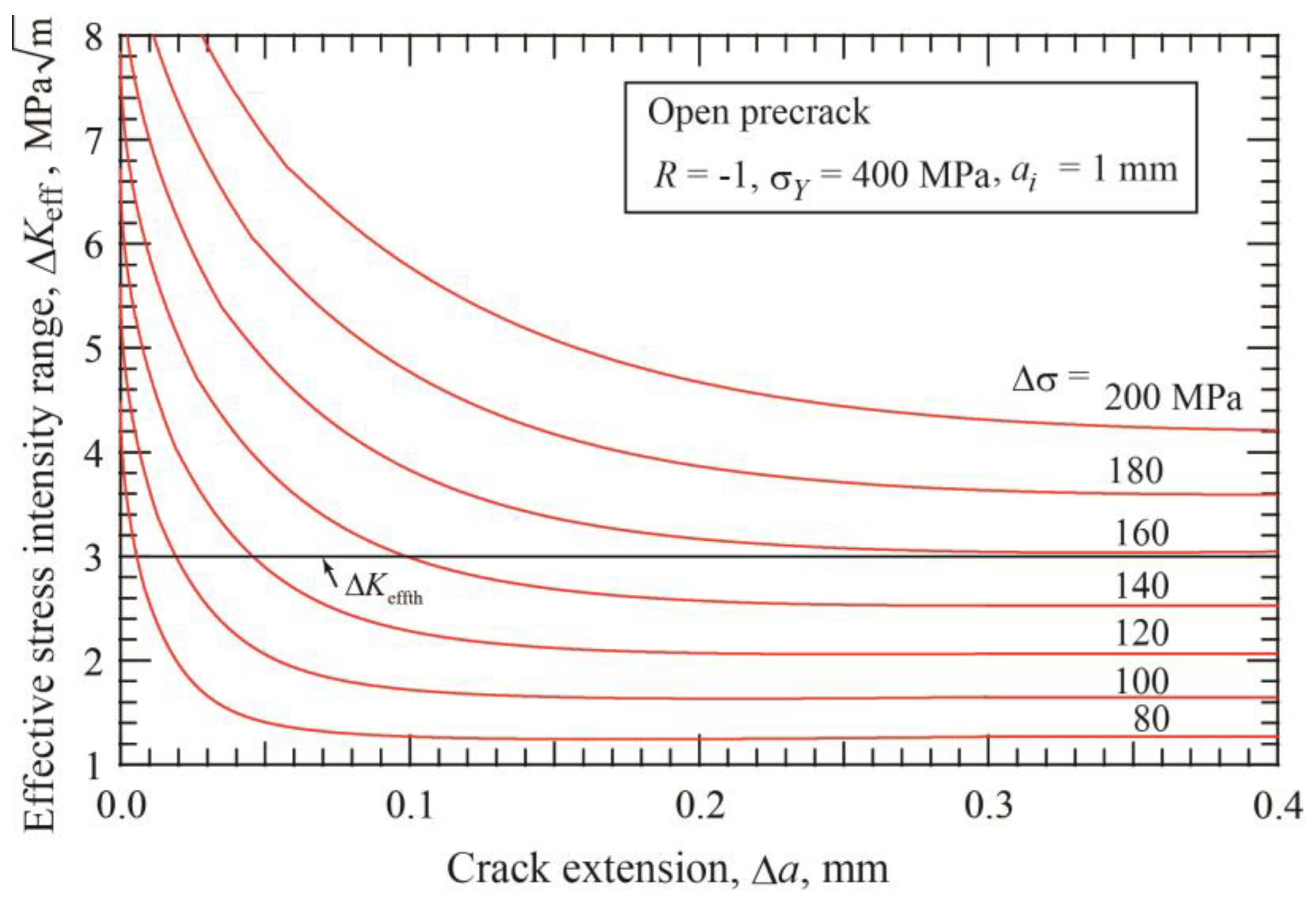
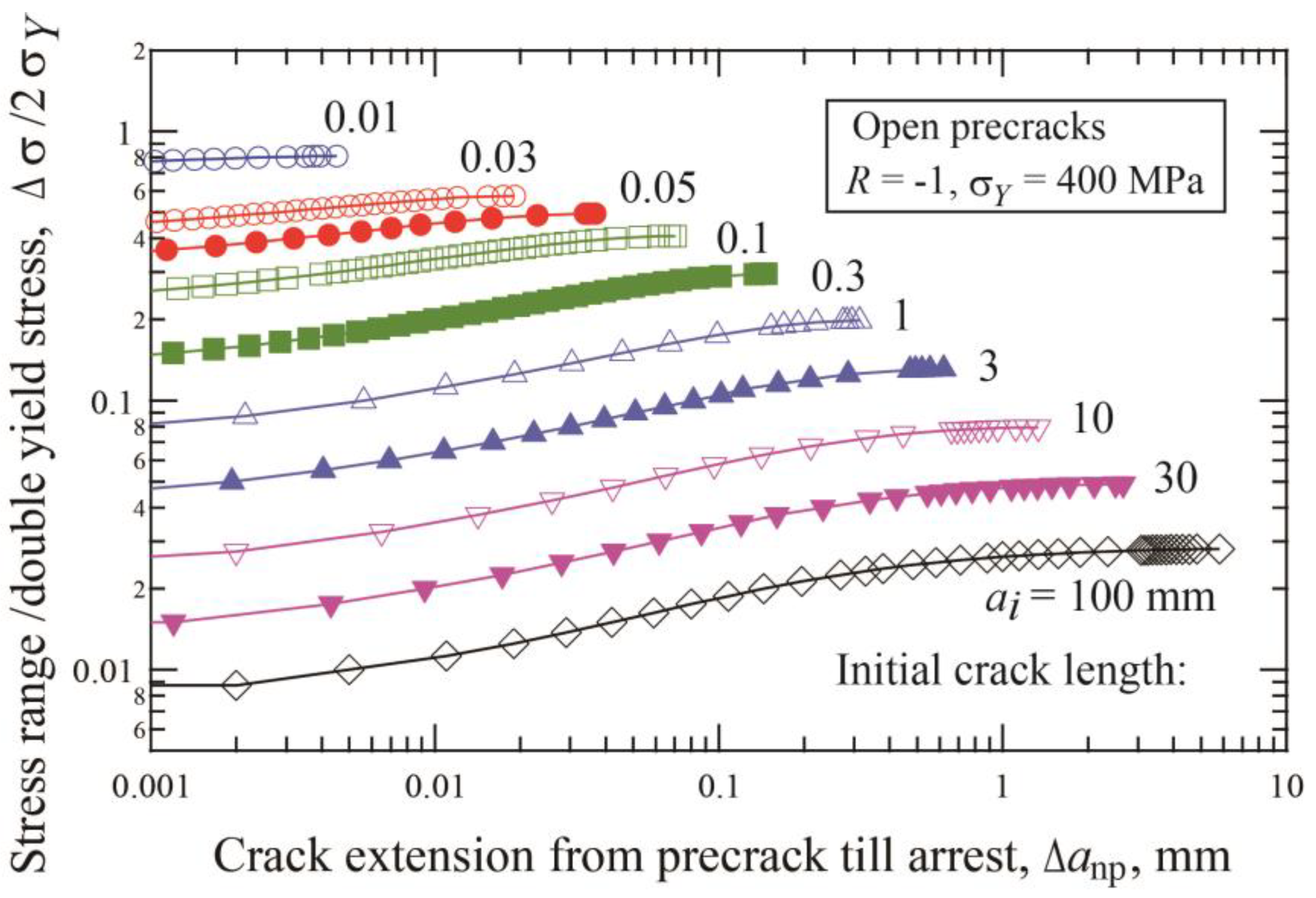
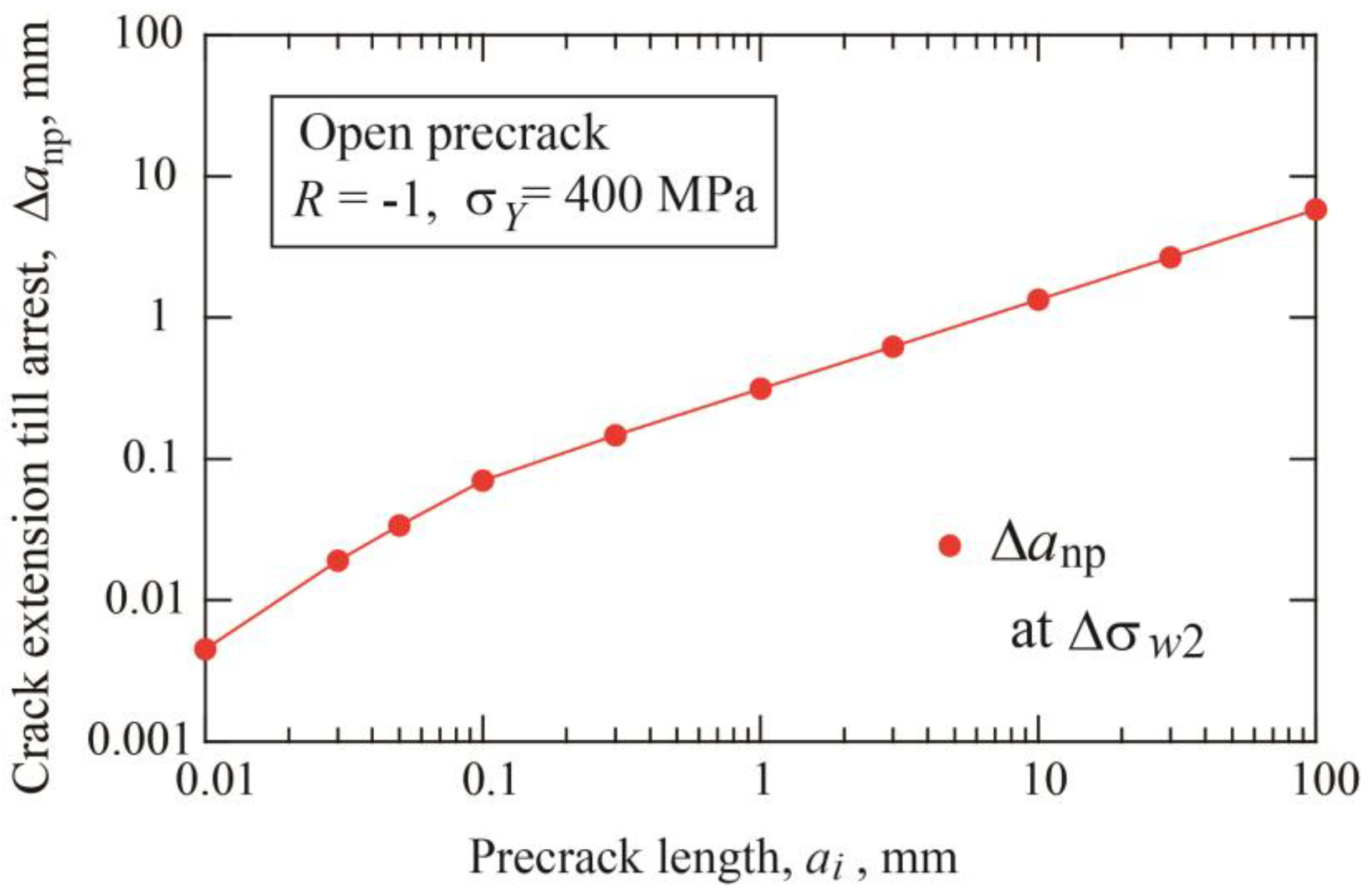
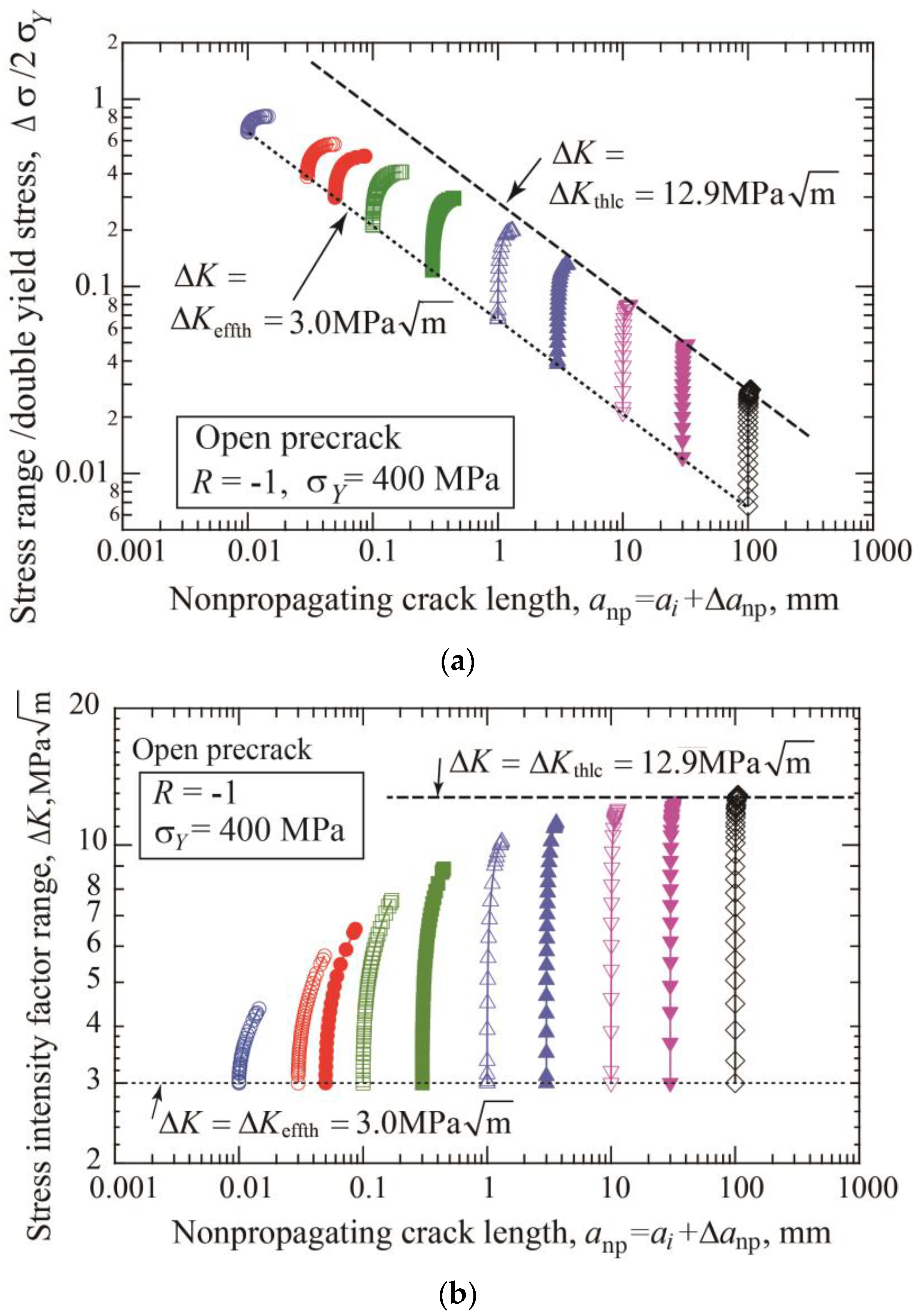

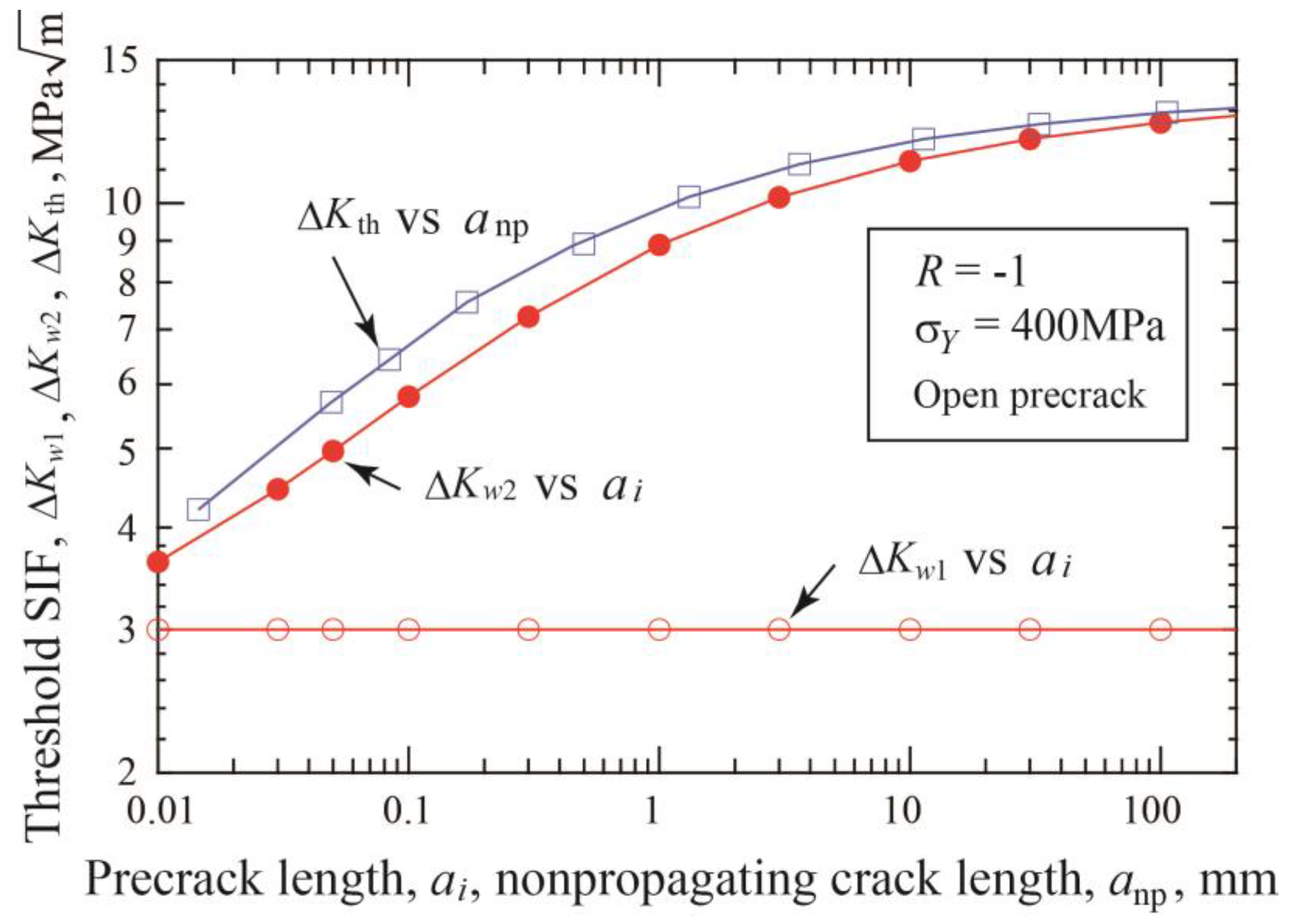
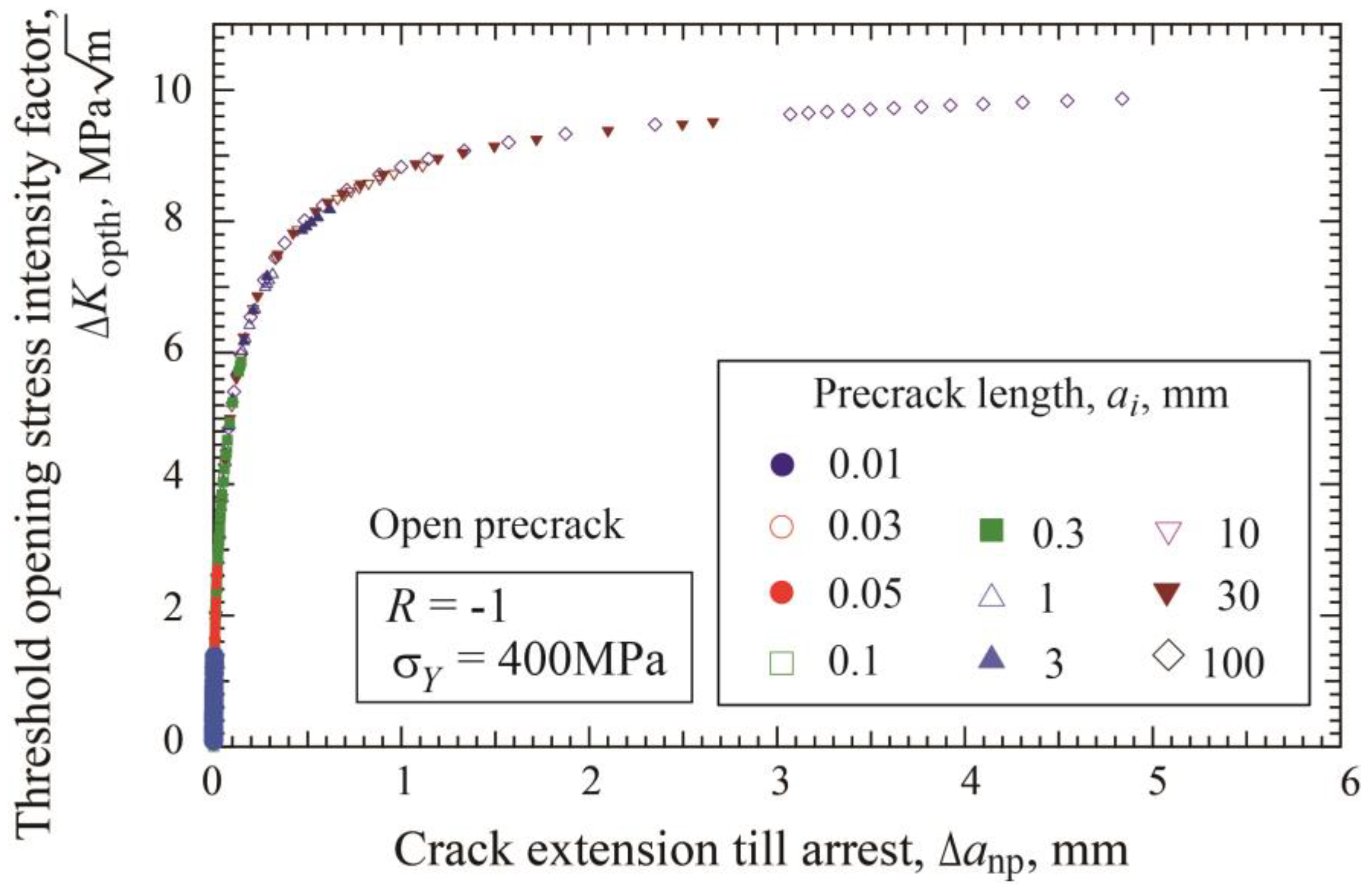

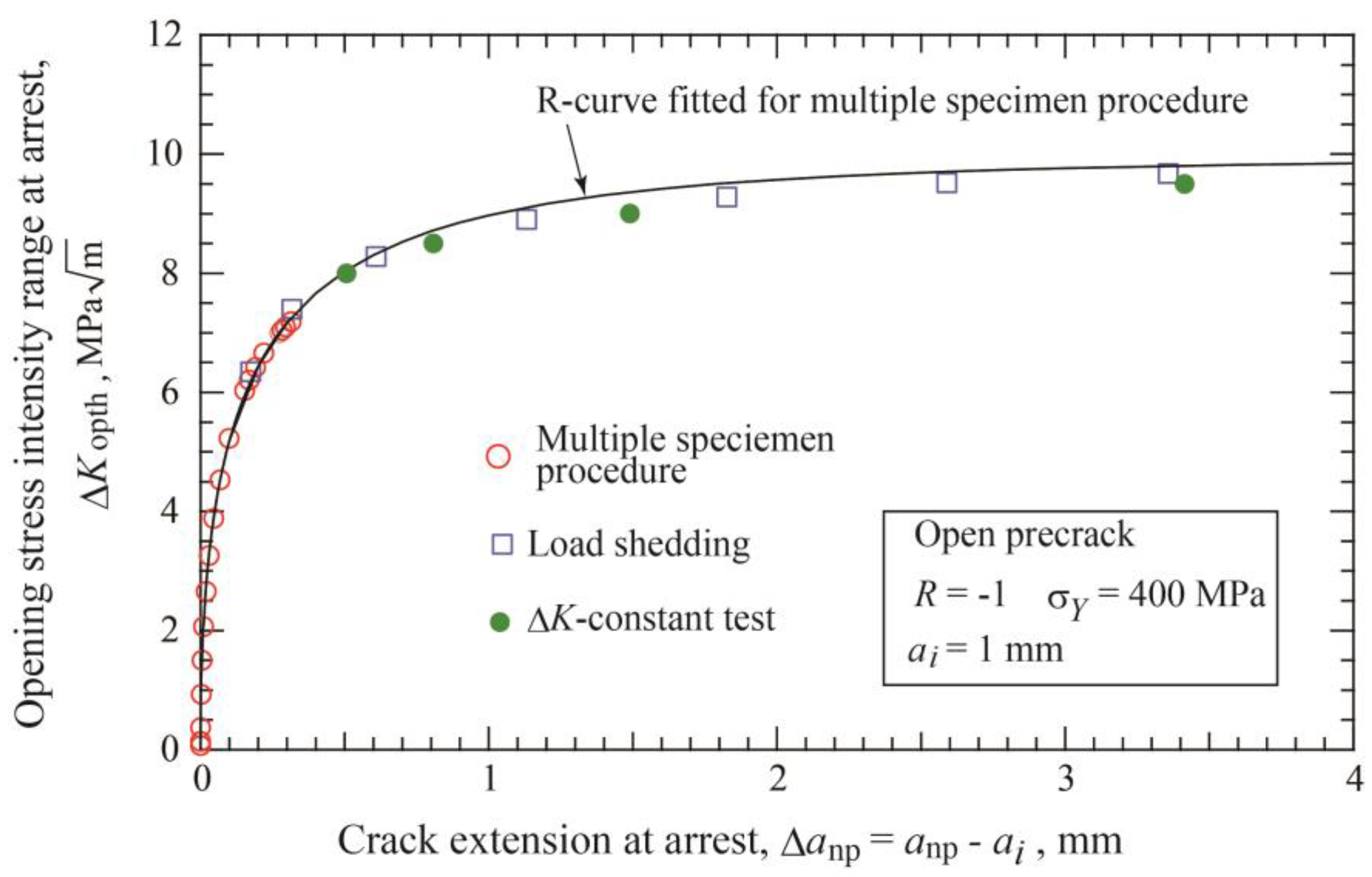
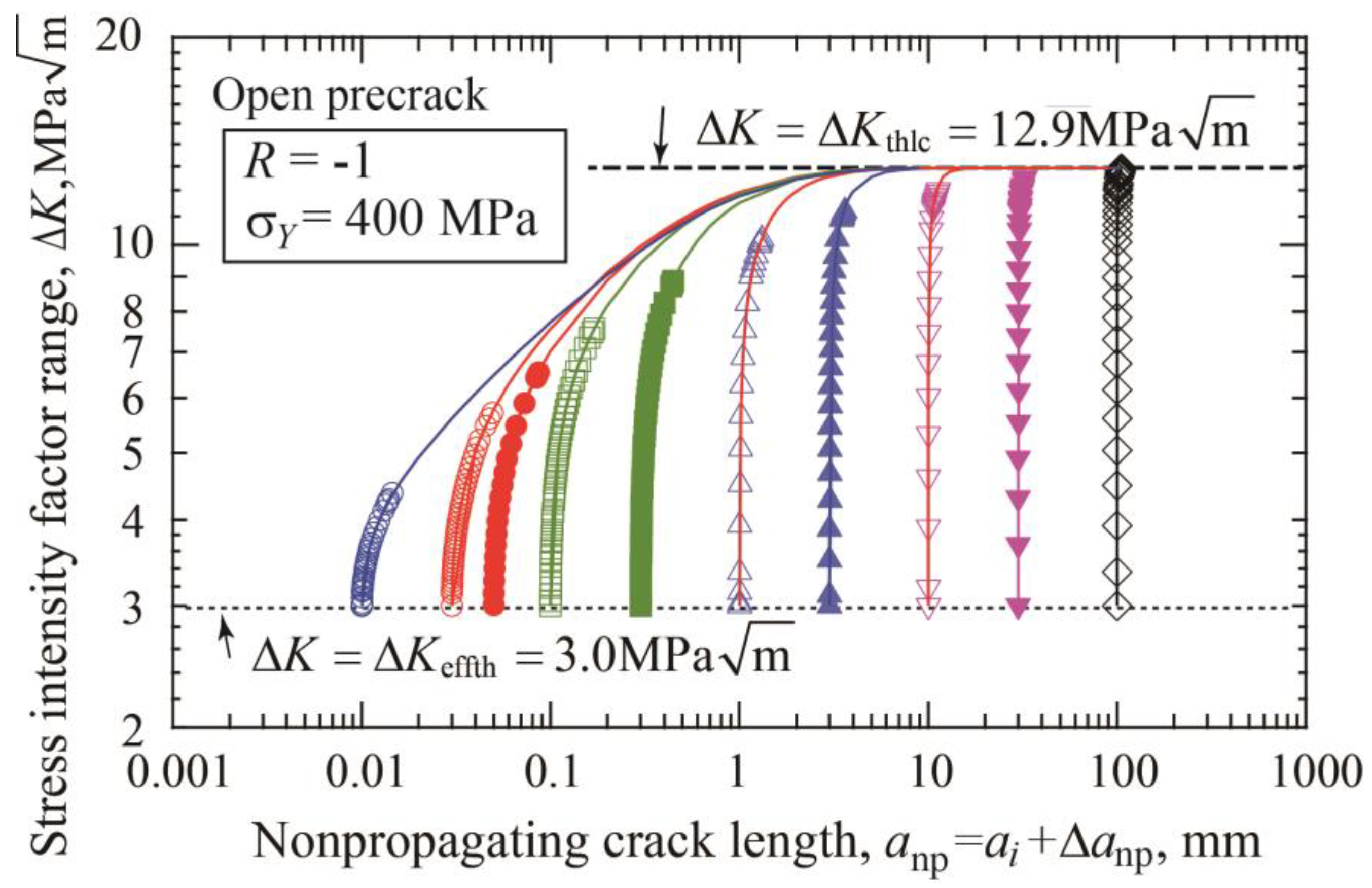
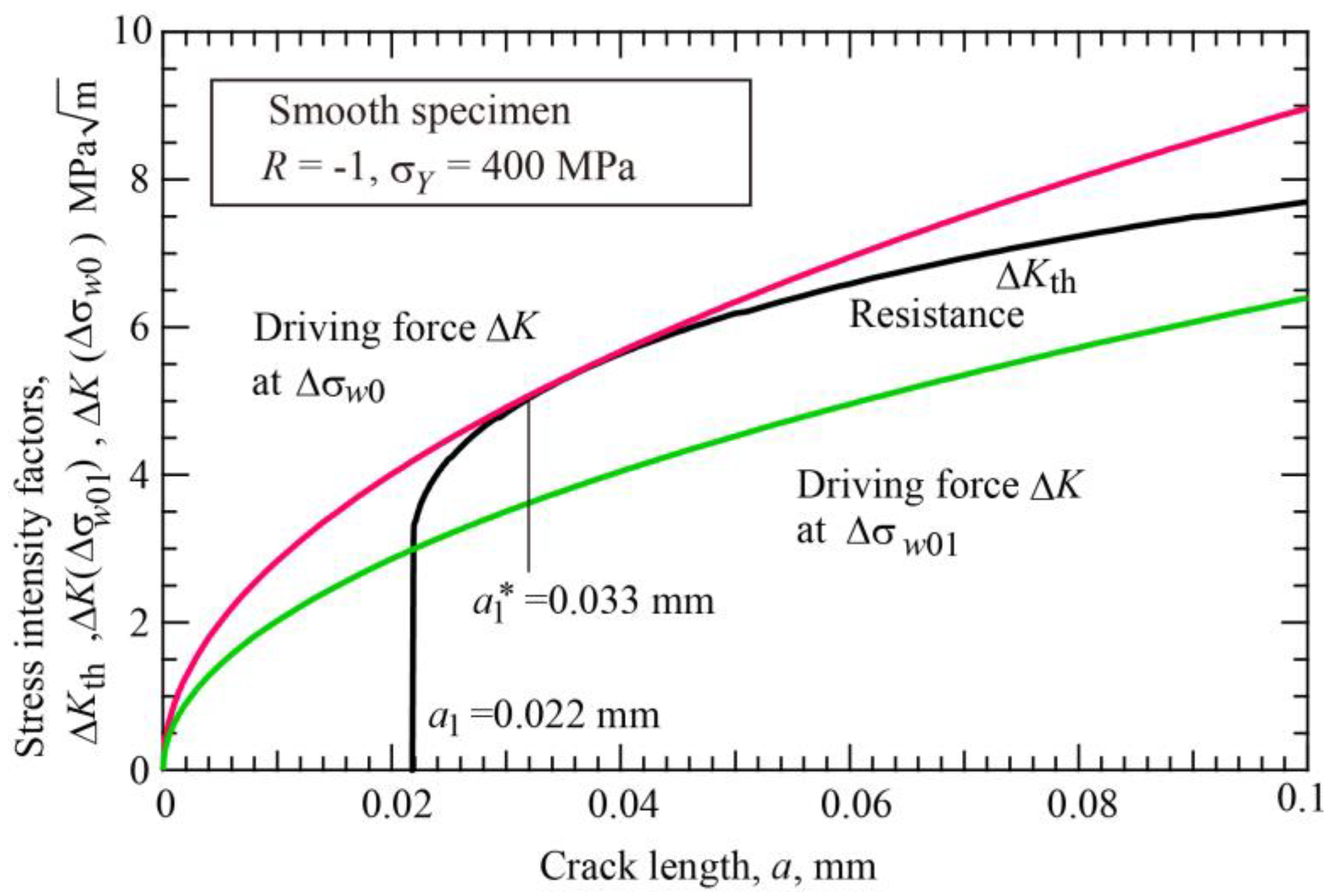

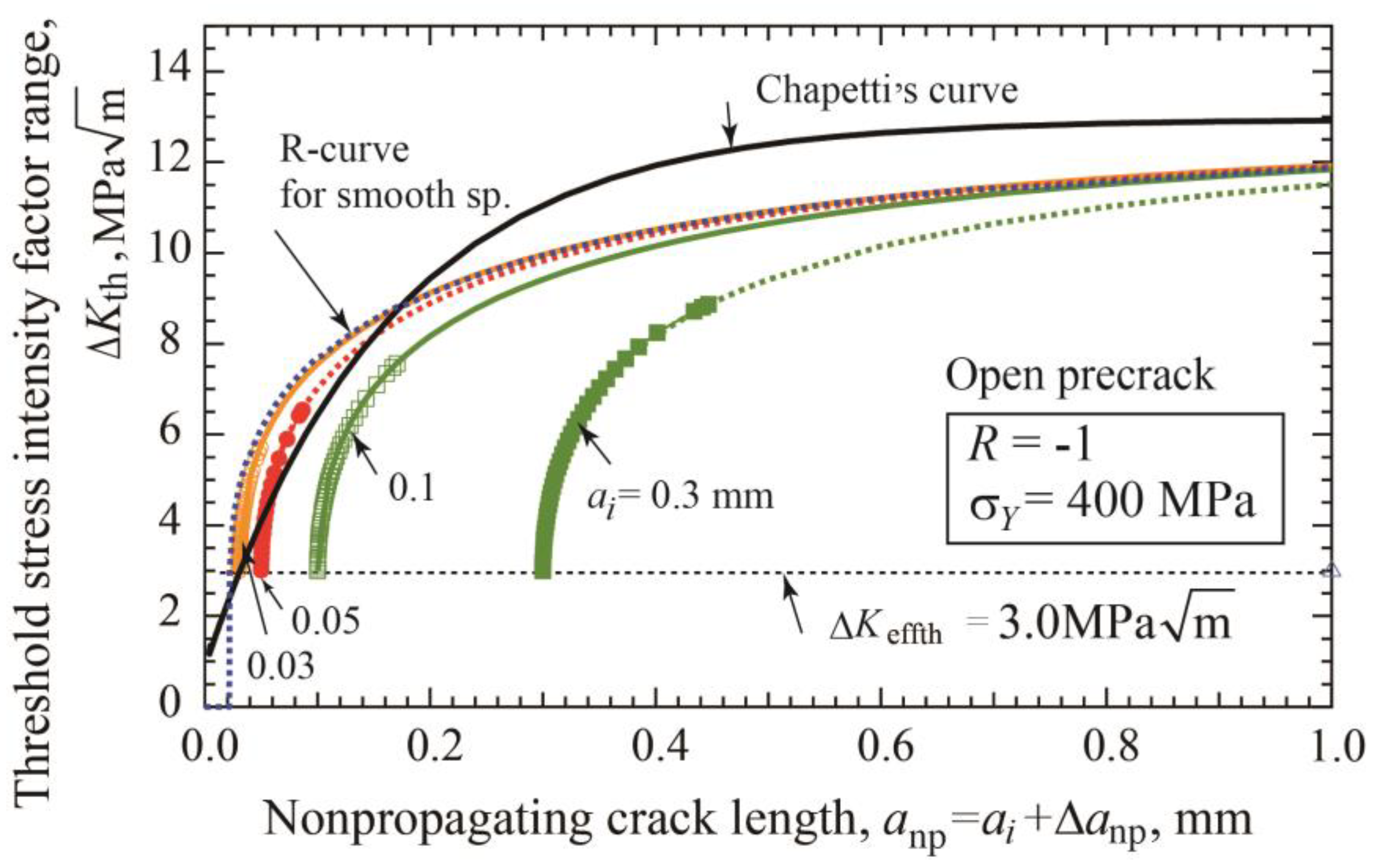
| Precrack Length ai [mm] | Threshold ΔKop for Long Crack ΔKopthlc | Threshold ΔKeff ΔKeffth | Threshold ΔKth for Long Crack ΔKthlc | Parameter in Equation (8) Δa1 [mm] | Parameter in Equation (9) Δa2 [mm] | Parameter in Equation (10) Δa3 [mm] |
|---|---|---|---|---|---|---|
| 100 | 9.94 | 3.00 | 12.94 | 0.157 | 0.186 | 0.253 |
| 1 | 9.94 | 3.00 | 12.94 | 0.172 | 0.184 | 0.266 |
| Grain Size d [mm] | Fatigue Limit Smooth Spec. (Fracture) Δσw0 [MPa] | Fatigue Limit Smooth Spec. (Crack Init.) Δσw01 [MPa] | Crack Initiation Length a1 [mm] | Fitting Parameter in Equation (14) Δa2 [mm] | Mi-cro-Threshold ΔKdR | Fitting Parameter in Equation (17) k [1/mm] | Fitting Parameter Δa1 = 1/k [mm] |
|---|---|---|---|---|---|---|---|
| 0.004 | 506 | 361 | 0.022 | 0.186 | 1.17 | 6.19 | 0.162 |
Disclaimer/Publisher’s Note: The statements, opinions and data contained in all publications are solely those of the individual author(s) and contributor(s) and not of MDPI and/or the editor(s). MDPI and/or the editor(s) disclaim responsibility for any injury to people or property resulting from any ideas, methods, instructions or products referred to in the content. |
© 2024 by the authors. Licensee MDPI, Basel, Switzerland. This article is an open access article distributed under the terms and conditions of the Creative Commons Attribution (CC BY) license (https://creativecommons.org/licenses/by/4.0/).
Share and Cite
Tanaka, K.; Akiniwa, Y. Short Fatigue-Crack Growth from Crack-like Defects under Completely Reversed Loading Predicted Based on Cyclic R-Curve. Materials 2024, 17, 4484. https://doi.org/10.3390/ma17184484
Tanaka K, Akiniwa Y. Short Fatigue-Crack Growth from Crack-like Defects under Completely Reversed Loading Predicted Based on Cyclic R-Curve. Materials. 2024; 17(18):4484. https://doi.org/10.3390/ma17184484
Chicago/Turabian StyleTanaka, Keisuke, and Yoshiaki Akiniwa. 2024. "Short Fatigue-Crack Growth from Crack-like Defects under Completely Reversed Loading Predicted Based on Cyclic R-Curve" Materials 17, no. 18: 4484. https://doi.org/10.3390/ma17184484






